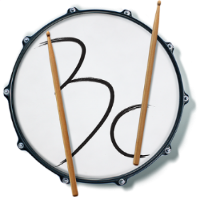Frankenstein Cyborgs: Hybrid Drum Sets
As electronics and computers advance and become more interconnected with instruments, the drums have also evolved and adapted electronic components. Sampling pads are a common sight among modern drummers of a variety of styles. Some drummers incorporate light shows and other visual elements that can be controlled using special sensors. Let’s take a look at some of the different ways electronics and computers work in conjunction with acoustic drums.
Rise of the Machines
Drums can communicate with software through the use of sensors, known as triggers (pictured right), placed on a head or cymbal. When an instrument with a trigger is played, a computer produces a programmed sound sample. Triggers on the bass drum and snare drum are frequently used in metal drumming to keep the volume of fast, repetitive strokes (like blast beats and crazy fast double kick) more even. E.g. the trigger on the snare will initiate a snare sample and the trigger on the kick will initiate a bass drum sample. However, there are many different uses for this technology.
Akira Jimbo uses triggers placed around his drum set to essentially command the sounds of big band horn sections or an orchestra without the use of a backing track, while Zach Danziger uses triggers to control video elements, lights, and voice samples. During this performance at University of Massachusetts Amherst, Danziger exhibits how he and a bass player have pushed the limits of live electronic music performance using triggers. However, triggers are sensitive technology and require a lot of time, money, and patience to learn and dial in. It’s not something most drummers get a chance to try without a relatively large financial and time investment. Thankfully, sampling pads make the benefits of triggers much more accessible by separating the electronic components away from the drums and into their own self-contained instrument.
A Buffet of Sounds
A sampling pad allows drummers to map specific sounds and effects to the layout of the instrument. Additional triggers can plug into the module, completely intertwining acoustic drums and electronic elements. The Roland SPD-SX (pictured left below), for example, contains 9 velocity-sensitive programmable pads, effectively expanding the range of an acoustic drum set by 9 voices. Drummers can control and use processed sounds live that would otherwise only be accessible in a studio setting. Sampling pads are most commonly used for auxiliary snare tones, hihat sounds, and sub kick samples.
Sunhouse produces a more futuristic approach to triggers with their Sensory Percussion drum sensors. With Sensory Percussion, each drum’s surface can be divided into many different zones, allowing a single drum to produce a huge range of sounds. The accompanying software (pictured right above) allows users to design unique sounds, or choose from a wide selection of preloaded samples and kits. Users can also program Sensory Percussion to control lights, giving drummers the ability to pull off elaborate multimedia live performances. Sensory Percussion can work in conjunction with acoustic drums, or with drums equipped with silent (mesh) heads. During this performance at the Brighton Music Hall in Allston, drummer Ian Chang, of the band Son Lux, uses a hybrid drum set including a sampling pad, Sensory Percussion, and acoustic drums and cymbals. Sunhouse has certainly pushed the possibilities of drumming in an exciting new direction.
The Organic Approach
On the other end of the hybrid setup spectrum, many drummers seek to replicate the sounds of electronic percussion using only acoustic instruments. Jojo Mayer is one such drummer that frequently prepares his drums to make them sound somewhat distorted. With the help of Sabian, Jojo designed the Hoop Crasher (pictured left), a pair of cymbal rings that lay around the inner circumference of a drum. When struck, they produce a metallic-sounding clap, characteristic of clap samples used in electronic music. Listen for the Hoop Crasher during this performance at Sonia near Central Square, Cambridge. Drummers commonly place splash cymbals, ching rings, and other small rattly instruments on top of drums and cymbals to diversify their sounds and mimic the samples of a drum computer. Chris Dave, for example, commonly plays on a set with multiple snare drums, tambourines, and sometimes bongos in place of toms to capture sounds characteristic of hip-hop drum samples.
In addition to taking drum lessons, it’s wise for Boston Drum Lessons students to study a bit of electronic music, too. Learning the basics of a DAW (Digital Audio Workstation) like GarageBand, Ableton, Reaper, etc., will further your understanding of music as a whole and could potentially inspire a new direction to take your drumming. In the meantime, see if you can differentiate between acoustic drums and electronic samples the next time you listen to music carefully. They’re frequently blended in lots of modern music, which makes distinguishing particular sounds quite tricky!





